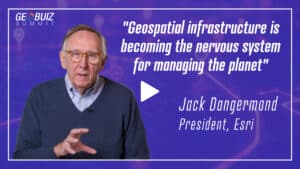The overwhelming deluge of structured and unstructured reports flooding intelligence agencies and defence organizations include critical location-based information, making processing and analysis an enormous and time-consuming task, often resulting in missed vital data points.
An innovative approach and solution are necessary to act as a decision support system, capable of efficiently reading, comprehending defense-specific terminology, acronyms, and jargon, and performing change detection, temporal, and predictive analysis.
A New Solution
The need for a “Geo-Int” solution has become increasingly apparent as organizations seek to transform unstructured data into actionable insights. However, analyzing this type of data can present challenges as it is not organized in a predefined manner.
Creating effective translation and visualization strategies is crucial to converting unstructured data into actionable insights. This involves using natural language processing and machine learning algorithms to structure the data, enabling it to be analyzed. The importance of leveraging advanced technologies, such as artificial intelligence and machine learning, cannot be overstated, as they can automate the process of structuring and analyzing unstructured data.
Location analytics play a vital role in the visualization strategy, ensuring that the actionable insights have effective visualization techniques that are relevant and show the prevalence of the incident/information in a geographical aspect. Effective visualization strategies involve using data visualization tools in a common frame and dashboard with a complete geo-enabled interface to create meaningful and insightful visual representations of the data. This results in a robust integrated “Geo-Int” platform.
Overall, advanced technologies like NLP, AI, ML, and Deep Learning are valuable resources that can be used to identify patterns and insights in the data that would be difficult or impossible to detect through manual analysis. Organizations seeking to leverage unstructured data to gain valuable insights and drive organizational efficiency should consider adopting these tools and techniques.
Traditional Challenges
There are several traditional challenges involved in building a platform that integrates and analyses diverse sources of geographic data. Some of these challenges include:
The integration of geographic data from diverse sources such as satellite imagery, IoT sensors, and business data poses a challenge due to variations in data formats, structures, and quality levels necessitating advanced data processing techniques that encompass data normalization, cleaning, and transformation; successful integration requires sophisticated data processing techniques.
Location analytics play a vital role in the visualization strategy, ensuring that the actionable insights have effective visualization techniques that are relevant and show the prevalence of the incident/information in a geographical aspect
As a logical next step, we need to look at the scalability of the system. To accommodate the massive amounts of geographic data generated, particularly when using high-resolution satellite imagery or IoT sensor data. To handle this data at scale, the platform must be designed to scale dynamically to accommodate increasing volumes of data over time. This requires a distributed architecture that can distribute processing across multiple servers and storage systems as needed.
When working with geographic data, it’s important to keep in mind that data quality can be a major concern. Geographic data is often prone to issues such as inaccuracies, incomplete data, and inconsistencies, which can all affect the reliability and usefulness of the data.
When integrating geographic data from multiple sources, these quality issues can become even more challenging to manage, as each data source may have its own unique issues and characteristics. As such, it’s essential to take a careful and systematic approach to assessing and addressing data quality.
When it comes to data security, location data poses a unique challenge. This type of data can be highly sensitive, especially when it contains information about critical infrastructure or individuals. Therefore, it is crucial to implement robust security measures to protect it. Whether the data is being transferred between different systems or stored in databases, security must be a top priority to prevent unauthorized access or theft of sensitive information.
Data Analysis and specifically Big Data in sync with Unstructured Data is complex and resource-intensive, requiring significant computing power and storage. Analyzing geographic data has become an increasingly important task. However, it requires advanced analytical techniques, such as machine learning, artificial intelligence, and deep learning, to effectively extract insights and patterns from the data. Furthermore, the accuracy of the analysis depends on the quality of the data, which can be challenging to collect and manage. As a result, effective geographic data analysis requires a combination of technical expertise, powerful computing resources, and a deep understanding of the underlying data.
Desired Outcomes
The desired outcomes of a location and behavioural data platform are varied and numerous. Interactive dashboards provide a high-level view of key performance indicators (KPIs) and trends, while predictive models use historical data to forecast future outcomes. Heat maps help visualize patterns and trends in geographic data, while data reports provide a detailed view of specific metrics and trends.
Change detection is a primary strategy of Geo-Int, allowing organizations to understand changes in statistical, behavioral, and geospatial data. Mobile applications provide real-time access to relevant data, and edge analytics allow for data collection and processing to occur near the location where the data is created or consumed.
Finally, natural language processing (NLP) enables machines to understand and extract meaningful insights from unstructured text data, making it possible to convert unstructured data into structured and actionable insights. These innovations in transforming unstructured data into actionable insights are rapidly changing the field of data analysis and visualization.
With interactive dashboards, users can identify patterns, trends, and outliers quickly, empowering them to make data-driven decisions with greater speed and accuracy. By providing a high-level view of data, interactive dashboards are an invaluable tool for organizations looking to leverage their data assets to gain a competitive advantage.
These dashboards can be customized to meet the specific needs of different stakeholders, providing them with insights that are most relevant to their roles and responsibilities. Whereas, Predictive models are an essential tool for any organization seeking to gain a competitive advantage through data analytics. These models are built using historical data to forecast future trends and outcomes. Predictive models can help organizations identify potential risks and opportunities before they occur, providing valuable insights into future outcomes. By leveraging predictive analytics, organizations can make more informed decisions, allocate resources more effectively, and optimize their operations for maximum efficiency.
The process of understanding change is a crucial component and strategy of Geo-Int. Changes can occur in statistical, behavioral, and/ or geospatial data, and can be detected through various means. Statistical data is collected from various sources and then transformed into a structured format for analysis.
With IoT Devices taking prominence in 5G Networks, Edge Analytics is growing. The idea that data collection and data processing can be performed near the location where the data is either being created or consumed is primary to any time-bound, result-oriented actionable intelligence. And hence, it forms an integrated part of the workflow in digital transformation.
This makes mobile applications becoming increasingly important deliverables of geographic data platforms. These applications provide users with real-time access to relevant data, allowing them to make informed decisions on the go.
Driving Results
In today’s data-driven world, organizations are constantly collecting vast amounts of data from various sources. However, much of this data remains unstructured and therefore, difficult to analyze and extract insights from. To tackle this challenge, a combination of advanced technologies can help convert unstructured data into structured and actionable insights. Innovations in the field of transforming unstructured data into actionable insights is quickly undergoing change.
Cloud-based tools and platforms provide scalable and flexible data processing and storage solutions, making it easier to convert unstructured data into actionable insights
According to experts, Natural Language Processing (NLP) is a key technology that can enable machines to understand, interpret, and generate human language. NLP can identify sentiment, key phrases, entities, and other important information from text data, making it possible to convert unstructured data into structured and actionable insights.
Another critical technology is Image Recognition. By using computer vision algorithms, Image Recognition can identify objects, faces, species, and other important information from visual data such as images and videos.
Graph databases, another essential technology are ideal for storing and processing complex data relationships between different data points. By using graph databases, organizations can uncover hidden patterns, relationships, and insights that are difficult to identify using traditional data analysis methods. Data visualization tools enable organizations to create visual representations of data, making it easier to identify trends, patterns, and relationships within unstructured data.
Cloud Computing is another crucial technology that provides organizations with the processing power and storage capacity needed to handle large volumes of unstructured data. Cloud-based tools and platforms provide scalable and flexible data processing and storage solutions, making it easier to convert unstructured data into actionable insights.
Finally, Augmented Analytics combines AI and machine learning technologies with data visualization tools, making it easier for analysts and data scientists to generate insights from unstructured data. By using machine learning algorithms, Augmented Analytics platforms can identify patterns and relationships within unstructured data, providing valuable insights that can help organizations make data-driven decisions.
It is recommended for a combination of advanced technologies such as NLP, Image Recognition, Graph Databases, Cloud Computing, Data Visualization Tools, and Augmented Analytics to convert unstructured data into structured and actionable insights.
ALSO READ: Data That Binds: Open Source Mapping For a Better Tomorrow










